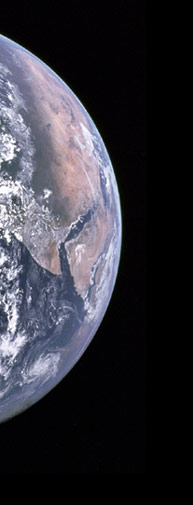|
Space Weather and You
The sun is a dynamic
system, and its dynamics can and do affect us here on earth.
Let’s look at some of
the effects due to solar activity:
Satellites and Spacecraft
Satellites and spacecraft are affected by solar activity both directly
and indirectly. High-energy particles from the sun can have direct
impact by destroying sensitive microchips. Incoming charged particles
can create buildups of charge inside electronics, resulting in
destructive arcing and false signals. Also, particle bombardment
can degrade the solar panels that supply electric power—a
potentially fatal development if that power is being used for
life support systems on spacecraft.
Indirectly, space weather can affect satellites
by heating the upper atmosphere and causing it to expand. The
expanded atmosphere is denser at higher altitudes, and this greater
density puts a drag on orbiting satellites. Slowed by this drag,
satellite orbits decay and ultimately require “boosting,” lest they burn up in the earth’s dense lower atmosphere.
Radio Communication
Shortwave radio communication (used mainly by the military and
for long-range broadcasts) works by bouncing radio signals off
a charged layer of particles in our atmosphere called the ionosphere.
Geomagnetic storms disturb the ionosphere, making radio communication
spotty and sometimes impossible.
Navigation
Most navigation systems rely on GPS, the Global Positioning System,
which in turn relies on carefully timed and triangulated signals
from satellites. Geomagnetic storms cause sudden variations in
the density of the ionosphere. As a result, GPS signals from
satellites arrive at GPS receivers slightly early or late, leading
to inaccuracies.
Meanwhile, geomagnetic storms may affect animal navigation too.
Many migratory animals have internal biological compasses, thanks
to tiny grains of a magnetic mineral (magnetite) in their brains.
Geomagnetic storms may disorient these animals, causing whales
to beach and carrier pigeons to lose their way.
Electric Power Transmission
Geomagnetic storms induce electric currents in the cables and transformers
of electric power systems. These induced currents can damage
equipment, leading to power failures. A geomagnetic storm on
March 13, 1989, caused a major blackout in Quebec, leaving six
million people without power. With warning from space weather
forecasters, power companies can take steps to minimize failures.
Pipelines
Geomagnetic storms can also induce electric currents in pipelines,
such as those used to transport oil. Electric current flow in
these pipelines causes them to corrode rapidly, leading to expensive
repairs.
Astronauts and High-Altitude Travelers
Radiation and high-energy particles from the sun can damage living
tissue. Here on the ground, we are protected by the combined
action of the
magnetosphere
and the atmosphere. However, astronauts
are subject to potentially lethal doses of radiation.
In addition to space travel, high-altitude flights on polar routes
during geomagnetic storms can expose crew and passengers to increased
radiation. Airlines monitor space weather forecasts and sometimes
make changes to flight paths during solar storms to lessen this
exposure.
Climate
It is already known that changes in the energy output of the sun
can affect the climate here on earth. For example, the sun undergoes
an 11-year cycle of activity, also known as the solar cycle.
During solar maximum, the peak of the 11-year cycle, the sun
shines a tiny bit brighter (up to one half of a percent). Studies
of tree-ring thickness show that plant growth follows the ups
and downs of the solar cycle. Another example is a historical
event called the Maunder Minimum, a 65-year dip in solar activity
that caused a period of global cooling on earth in the late seventeenth
century. During this time, known as the Little Ice Age, temperatures
plunged and the Baltic Sea froze over regularly.
Scientists are speculating that galactic
cosmic rays (high-energy particles from outside our solar system)
may also affect the earth’s
climate. Some think that cosmic rays are involved with cloud formation
in our atmosphere because they create ions (charged particles)
in our atmosphere; ions act as “seeds” (or nucleation
centers) for clouds.
|




